IELTS Listening Test is the first part of the IELTS exam. The duration for IELTS Listening Test is almost 30 minutes. The test format consists of 4 sections and a total of 40 questions are asked in the exam.

Essence of IELTS Listening
A variety of tasks are used in IELTS listening that is chosen from the following types:
- Multiple-choice
- Short-answer questions
- Sentence completion
- Form/note/summary/diagram/flow-chart/table completion
- Diagram/plan/map labeling
- Matching
IELTS Listening: Format
First of all, you need to understand the test format so that you can start preparing accordingly for the exam. Before we start discussing the ways to get a good score in the IELTS listening test, let’s discuss some of the salient features of this test.
- There will be a total of 40 questions asked in the IELTS listening test.
- An audio will be played which consists of conversations, both academic discussions, and general conversations.
- The audio will be played just once. The test takers are not allowed to stop or pause the test in between.
- Sometime in the beginning you will be provided time to read all the instructions and the questions.
- The candidates will be rewarded with one mark for every right answer while no marks will be deducted for incorrect options chosen by an applicant.
- The candidates will get a separate answer sheet for the listening test, and they will get 10 minutes to write the answers on the answer sheet.
- The candidates must go through all the instructions carefully.
IELTS Listening: Assessment factors
The IELTS Listening section of both, IELTS Academic and IELTS General Training will be the same. The candidates will get a band score of IELTS listening post the completion of the test. The band score varies from 0 (lowest) to 9 (highest). The aspirants will also receive a combined score in all four sections, which are Listening, Reading, Writing, and Speaking. They will get 1 mark for every correct response.
The IELTS 9 band scale is used for calculating the overall score of the candidates in IELTS General Training and IELTS Academic. The examiners test the listening ability and understanding of the language of the candidates.
Determining Factors
| Factors | Details |
| Total Number of Questions | 40 |
| Marking | One mark for every correct response |
| IELTS Band Scale | 1- Lowest and 9-Highest |
IELTS Listening Band Score: Conversion of Marks
The certified markers who mark the test regularly monitor it to ensure reliability. The Cambridge Assessment English analyses the answer sheet carefully after the completion of marking. A band score conversion table is made for various versions of the listening test. The raw score out of 40 gets converted into 9 band scale. The aspirants will get one mark for every correct response.
IELTS Listening
| Band score | Raw score out of 40 |
| 5 | 16 |
| 6 | 23 |
| 7 | 30 |
| 8 | 35 |
The Difference Between Paper‐based and Computer-based IELTS Test
In the offline IELTS exam, the four sections including Reading, Listening, and Writing are asked. However, the speaking test will be organized by a trained IELTS examiner through a face-to-face interview.
- All four sections including the Reading, Listening, and Writing sections will take place on a computer in case of a computer-delivered IELTS test.
- The Speaking test will be conducted in the face-to-face method with IELTS examiners.
- The IELTS exam will be completed on the same day for both paper and computer-based formats.
- The speaking section can be organized a week after or before the other tests.
Computer-Based Verses Paper-Based IELTS: Key Pointers
The main differences between computer-based and paper-based IELTS formats are detailed below:
The Paper-based IELTS comes with an answer sheet and a pencil for writing. The candidates are supposed to write answers on this sheet within the given time. While in an online IELTS test, the test takers have to type answers in their respective boxes on the screen. The students will get a pencil or pen and some paper to make notes in this format. The computer test can be tailored for one having some basic typing abilities.
Similar to the paper-based IELTS examination, the online IELTS also starts with Listening, followed by the Reading and Writing tests. The Speaking test will be conducted on the same day before or after the computer-based examination.
In the paper-based IELTS format, the candidates are supposed to write answers in the question booklet while hearing the recording. They get 10 minutes towards the end for transferring the answers to the official answer sheet. The candidates have to type their answers in suitable boxes on the screen in the computer-based format. They will get some time in between the parts for examining answers, but no extra time will be provide at the end.
The paper-based IELTS exams are conducted in spacious rooms, maybe at educational institutions and universities. The online IELTS tests are custom-tailored and conducted in smaller rooms as well.
IELTS Listening Question Types
The IELTS Listening test remains the same for both the IELTS Academic test and the IELTS General Training test. The test takers are supposed to answer 40 questions in response to four recordings. The test takers will listen to four recordings which are a mixture of monologues and conversations from a range of native speakers. Make sure to listen to all the recordings carefully as you will hear each recording once. A total of 10 questions for each part will be asked in the Listening test.
- Recording 1: In this, a conversation between two people is shown interacting with each other in a social context.
- Recording 2: A monologue set in an everyday social context, for instance, a speech regarding the local facilities.
- Recording 3: A conversation between a maximum of four people set will be provided. The conversation could be between a university’ teacher and a student deliberating a particular assignment.
- Recording 4: A speech on any subject related to academics, for instance, a university lectures.
The Kind of IELTS Listening Questions Asked in the Test Includes:
Multiple Choices
- Multiple choice questions have one correct answer or sometimes more than one correct answer as well. The candidates have to read the question very carefully to check how many answers are required.
In MCQs, the candidates have to choose one correct answer (A, B, or C), you will be given:
- A question followed by 3 outcomes.
- The beginning of a sentence is followed by three or more possible ways to complete the sentence.
- In these kinds of questions, where you are supposed to choose more than one correct answer you will be provided with a longer list of possible answers and told that you need to select more than 1 option.

[Source – https://www.ieltsjacky.com/types-of-ielts-listening-questions.html]
In the first one, a Short Answer Multiple Choice Question will be asked. It consists of a question and some answers for you to choose from.
Have a look at the example mentioned underneath:

The second kind of IELTS Listening consists of Completion of Sentence – Multiple Choice Question. The starting of the sentence follows a question with 3 possible answers. The students need to choose any 1.

Matching
The candidates have to match a numbered list of items from what they have listened in the listening audio to a set of options on the question paper. The set of options might have some criteria of some kind.
These types of questions are added to assess the candidates’ listening skills for detail and whether they can understand the information provided in a conversation related to a regular topic, like identifying various types of schools or colleges. It also assesses the individual’s ability to follow a conversation between two people and is used to assess relationships’ ability and interrelation between facts in the listening text.
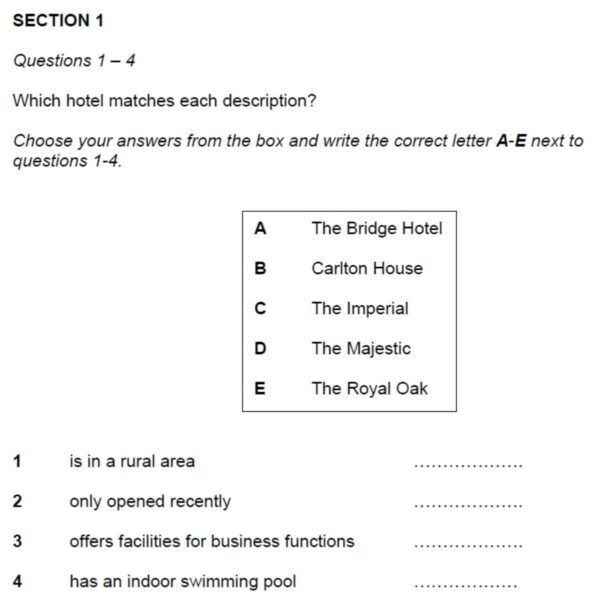
PLAN/DIAGRAM LABELLING/MAP
In this task, the candidate has to fill the labels on a plan (e.g. of a monument), map (for instance a part of a village), or an image (an item’ piece). The candidates can choose their answers from the mentioned question papers. This matching task assesses the individuals’ ability to understand, for example, a description of a place, and to relate this to a visual representation.
Plan Labeling
This kind is related to completing a plan (e.g. of a factory), a map (e.g. of a state area), or an image (e.g. a part of a device). There will be some answers to select. The content of the listening recordings is mostly non-academic. In many cases, the candidates are provided with an introduction about an event or about the structure, or the plan of a building (for example a trip to a museum, gallery, school…)
Example:

Map labeling
The second kind is Map Labeling. There are several places like a hospital, factory, and park… and the candidates have to carefully listen to the recording, look at the given map and label all the gaps in that map.
This kind of question aims at testing the listening and imagination skills on the map of a particular place. Therefore, the ability to obtain spatial language is of utmost importance for you to complete this task.
Example:

Diagram Labeling
The third and also the last format in IELTS listening questions is Diagram Labeling. It will give you a diagram that can demonstrate the parts of a machine, or phases of a process. The speaker in the recording will provide details about the diagram very clearly and logically so that the listeners can easily understand the same. As a result, it is important to keep a close track of what you hear, not what you think of from your own knowledge regarding the provided machine or process.
Example:

Form, note, table, flowchart, summary completion
In this completion task, you have to fill in the gaps in an outline of part or all of the listening text. The outline will focus on the primary facts/ideas given in the text. It might be –
A form: It is used for recording factual details like names, addresses, and telephone numbers.
Name: Oliver 1 ……………….
Delivery address: 2 17 …………………. Street, Chester
Postcode: 3 …………………….
Name of item ordered: 4 …………………
Number of items ordered: 5 …………………
A set of notes: It is used for summarizing information with the help of layout presenting different items linked with one another.
Example:

A table: It is beneficial in summarizing information that relates to transparent categories such as location or time.
Example:

A flow-chart: It is used to summarise a process that has clear stages, marking the direction process with the help of arrows.
Example:

Summary paragraph
The candidates have to fill in the gaps in the provided paragraph. Make sure that the answer meets all the requirements like spelling, grammar, and word limit.
Example:

Flowchart Completion
(Source: Official website www.ielts.org)
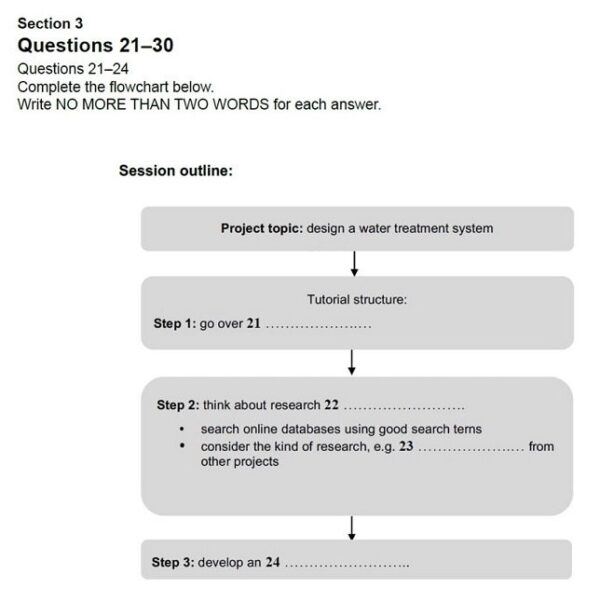
Sentence Completion
In this sentence completion task, the test takers are supposed to read a set of sentences consisting of all the information by either including all the text, or one part of it. The test takers can fill a gap in each sentence using the provided information from the listening text. Also take care of the given word limit, for instance, ‘NO MORE THAN ONE WORD AND/OR A NUMBER.
You must read all the instructions carefully as the required words differ. A word limit is provided, for example, ‘NO MORE THAN TWO WORDS AND/OR A NUMBER. If you use more than the word limit, the answer written by you will be considered incorrect, so always check the word limit required for every question. Words like ‘police-man’ “swimwear” etc. will be considered a single word.
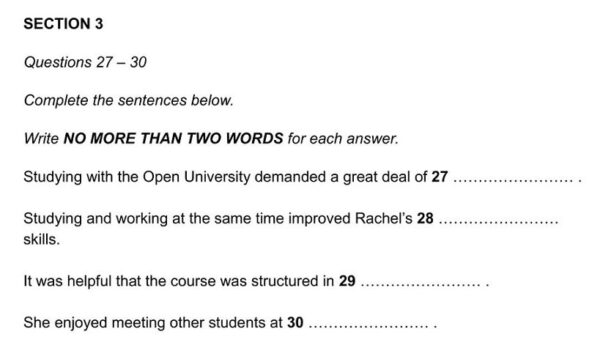
Sentence completion mainly focuses on the individuals’ ability to identify the main information in a listening text. It is crucial to understand functional relationships like cause and effect.
Source: Official websitewww.ieltsessentials.com
Table Completion
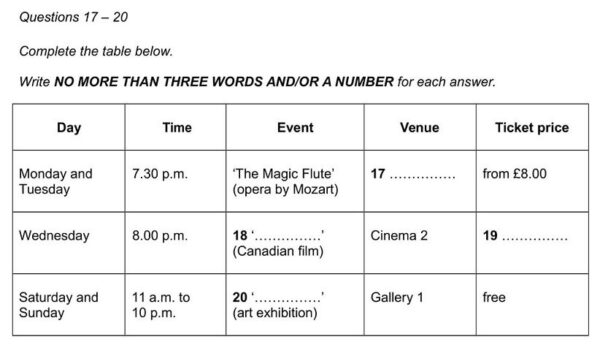
Short-answer questions
In the short-answer question type, the test takers have to read a question and then write a short answer with the facts provided during the listening. Many times the aspirants are presented with a question that asks them to list two or three points.
A word limit will be provided, for instance, ‘NO MORE THAN THREE WORDS AND/OR A NUMBER. If you use more than the required word limit, the answer will be taken as incorrect.
[Source: Official website www.ieltsessentials.com]
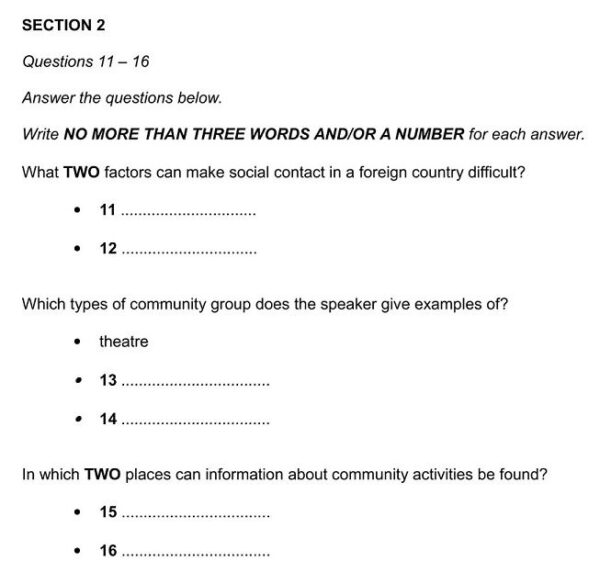
IELTS Listening: Rule of Thumb
The IELTS Listening test consists of 4 sections with 10 questions each in every section. The questions are designed in a way that all the answers will appear in the same order the candidates heard in the audio. The duration of the test is 30 minutes, and in these minutes, the students will listen and have to answer at the same time. The candidates can write or circle their answers and draft them in the question booklet.
Thus, it is important to make a well-defined plan, follow it strictly and try to work hard to fulfil your dream. During the given 40 minutes of listening time, one needs to stay really focused, for the same practice is very important. For every correct answer, candidates will get 1 point. Therefore, the best advice in case you have limited time is that instead of doing long question, do easy ones first. And the meaning of right here is spelling, grammar, and word limit as well.
In conclusion, when it comes to studying a skill, it is imperative to know what to learn before knowing how to learn. It means that one of the tips to get a good score in IELTS Listening is to know all the kinds of questions asked in the exam.
KEY STRATEGIES TO GET A GOOD SCORE IN IELTS LISTENING
So to make it clear, we are discussing some of the tips that can help you score good marks on the IELTS listening test.
- Listen to the recording
- Carefully listening to all kinds of recordings is important, make sure you listen to all the conversations carefully. Don’t just hear the recording rather try to understand what the speaker wants to say. You must improve your listening skills, which can be done by listening to English movies and shows. While answering the questions, the learners must carefully listen to the recordings and don’t be in a hurry.
- Keep your booklet ready
- Before the start of the recording, make sure you keep the booklet handy with you. While giving the IELTS listening test, placing the booklet in front of you helps read the texts and questions quickly. It eventually helps save time. Also, keep the answer sheet handy so that you can start writing the answers immediately. It is important to write down nouns and important words, which you heard while recording so that you can easily recall them later.
- Vocabulary is important
- Focus on your vocabulary skills and for the same, you can use the dictionary. As and when you hear a new word, pen it down on the paper. It is important to have a clear idea about the kinds of questions asked in the IELTS listening test and thus prepare accordingly for the same. The more new words you learn, the better it will be for you. As a learner, pen down difficult words in your notepad to work upon them.
- You will be able to listen just once
- While giving IELTS listening test, the aspirants get just a single chance to listen. Though most of us want to listen again, in this test it is not possible at all. So make sure you pay detailed attention and memorize all the information carefully. Try to improve your listening skills and look for ways that help improve your listening skills. By hearing different kinds of listening situations like lectures, conversations, chatting, etc. you can improve your listening skills.
- Focus on keywords
- At the time of the test, the recording will be played just once, and candidates will get time to read the instructions and questions before the start of the recording. Again, while reading the questions, highlight the important keywords, and try to predict the context of the recordings, who is speaking, and what the speaker wants to say in the speech. Think of some similar words that could be replaced, particularly, for the multiple-choice questions, as you might not be hearing the exact words in the recording.
- Make sure the sentences you produce are grammatically correct, and you use the best style of the word. The more you focus on practicing, the more benefits it will be. Reading extensively will help know different kinds of vocabulary and improve your reading speed.
- Stay away from all sorts of distractions
- What you hear the recording, watch out for the distractors. For example, the speaker might say one thing but then reverse the answer. You will also observe that the speaker mentions all the options with some differences in meaning. You need to pay attention to the details in the IELTS listening task.
FAQs (Frequently Asked Questions)
- Can I complete the IELTS test in a single day?
- Yes, all the sections of the IELTS exam get finished immediately after each other.
- Can I stop IELTS listening in the middle?
- Please note that there is no option to pause or restart the Listening test. The audios will not stop and you will have to continue answering the questions as you hear the recordings.
- What types of accents are used by the examiner in a Listening test?
- As IELTS is an internationally recognized exam, a variety of native-speaker accents of English are considered.
- How can I prepare for the IELTS Listening test online?
- We suggest you prepare with Study Smart online IELTS preparation courses as it covers interactive self-access lessons and practice tests in all 4 IELTS modules.
- Is there some difference among the Academic and General Training Listening Exam?
- No, they are similar.
